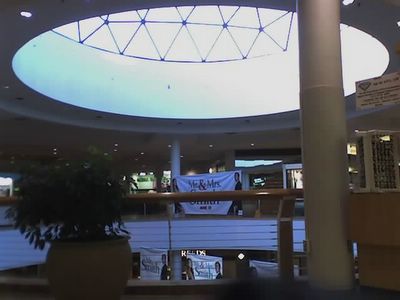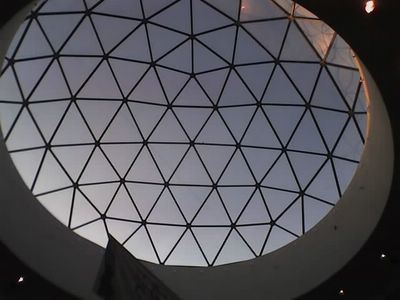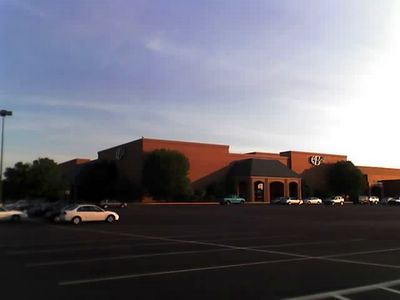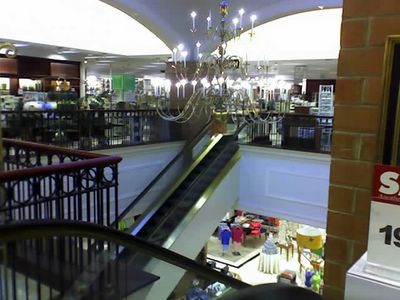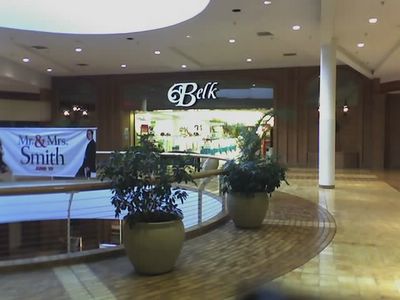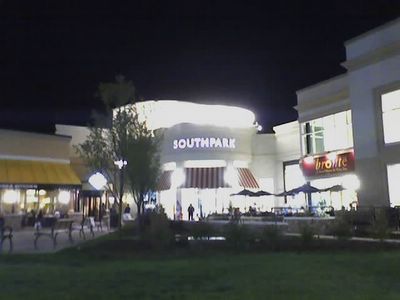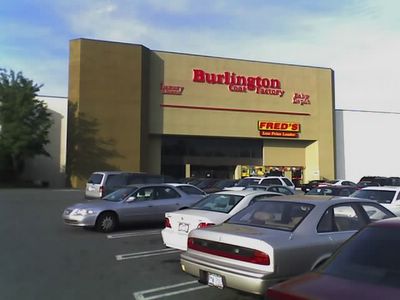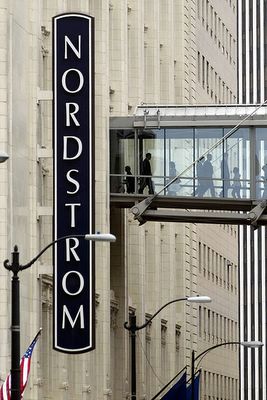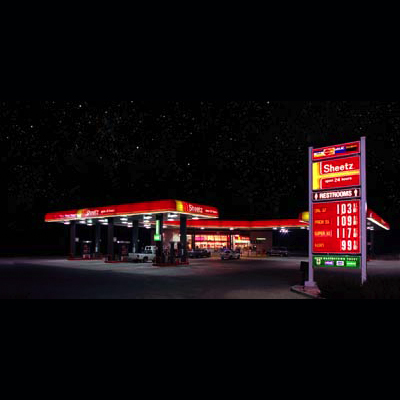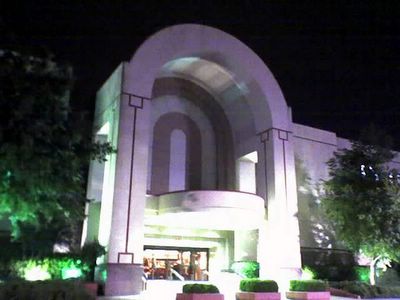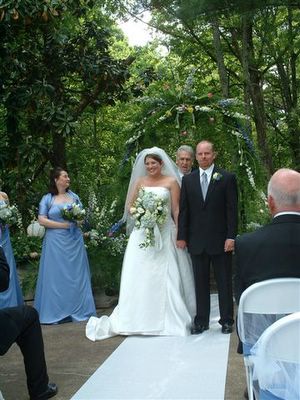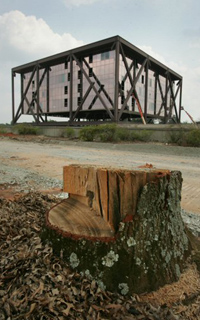 A stump from one of the trees cut down as demolition work continues at the old Burlington Industries headquarters building. The building is scheduled to be imploded on Monday. (H. Scott Hoffmann/© News & Record)
A stump from one of the trees cut down as demolition work continues at the old Burlington Industries headquarters building. The building is scheduled to be imploded on Monday. (H. Scott Hoffmann/© News & Record)
STORY BY STAFF WRITER JIM SCHLOSSER
News & Record
GREENSBORO - The architects and contractors assumed they were building for the ages.
They created for Burlington Industries a steel and glass edifice that was no copycat corporate headquarters.
It was unique, with crisscrossing steel trusses and 95,000 square feet of special mirror glass that employees could see out but outsiders couldn't see in. The center section stood six stories tall, with the upper four floors suspended from the roof trusses.
"Structural gymnastics" is how architects and engineers describe the designing and construction of challenging structures such as the Burlington Industries Building.
Those involved knew it needed to make a statement for Burlington Industries, at the time the world's largest textile maker. The new headquarters, with those heavy trusses, would symbolize Burlington's strength.
"Burlington Industries was as solid as a rock," said Charles Hicks, who worked for Odell Associates, the Charlotte architectural firm that designed the project. "I expected it to be there 75 years or more."
Instead, 200 pounds of explosives will make the building's center section vanish in seven seconds Monday, just 34 years to the month after it opened.
Demolition crews have already reduced the building to a skeleton, which also sums up Burlington Industries. It emerged from bankruptcy in 2003 and vacated its 430,000-square-foot headquarters last year. During Burlington's best years, the headquarters employed 1,250 people.
"Mayo," a piece of abstract sculpture that decorated the building's plaza and was beloved by employees, now stands in the weeds about 200 yards away from the plaza, which already has been demolished along with the two-story building that wrapped around the six-story tower.
It's a woeful end for a building that caused so much bitterness when proposed in 1968 and generated so much architectural and engineering creativity when built between 1969 and 1971.
It was one of the first North Carolina buildings built with computer help. Hicks said at the time that it took eight computer tries -- the computer took up two rooms -- to achieve the correct framing scheme for the steel trusses.
Whether one liked the architecture or not, the building caught the eye and immediately became a local landmark.
It was not just bigness that defined the headquarters. Attention was given to details.
Designers decided against standard ceiling vents for heating and air conditioning. Too unattractive, they said.
Instead, they hid the vents inside 12,000 light fixtures.
The grounds were cleverly landscaped to make parking lots invisible behind shrubs and berms. It looked as if the building had been placed in the middle of a park. A maintenance crew in golf carts pampered the grassy grounds and attended to many large trees, some original to the site, many added by Odell, which also did the landscaping.
The building, built by Daniel Construction Co., of Greenville, S.C., included a TV studio for making commercials, a cafeteria and product showrooms. A fountain that gushed recycled water greeted visitors at the entrance. The executive wing on the fifth floor had marble bathrooms and fine wood paneling in the halls and offices. President Charlie Myers had a guardrail built in front of a floor-to-ceiling window in his office. He had a phobia that kept him from getting close to large windows high above ground.
The building would win four national architectural awards and one regional award, and a U.S. Steel Corp. publication said in the early 1970s that "art and engineering have come together to produce a strikingly unusual building."
Benjamin Briggs, executive director of Preservation Greensboro, calls the Burlington Industries Building "one of the great buildings of the modern era in North Carolina." He refuses to ride out West Friendly Avenue, not wanting to see the now seedy structure surrounded by weeds and stumps from a tree clearing to make way for the site's next occupant, a shopping center.
Walter Bost of Kannapolis, a retired Odell architect who still does consulting work for the firm, called the demolition "ridiculous" and said "anyone with a creative mind" could have found a way to include the building's central section in the shopping center.
"That building is such an integral part of what the textile industry did for the South," Bost said. "It makes no sense to tear it down. If it were a piece of junk, all right, but it's not a piece of junk."
Some former Burlington workers also feel a sense of disbelief about what's happening.
Bill Beerman, a public relations specialist, started out in Burlington's old headquarters downtown. He watched as it was demolished last year to become the site of First Horizon Park.
Now the end is near for a building that he and others still call "new." It opened in May 1971, the same year the last major implosion took place in Greensboro, the 13-story King Cotton Hotel downtown. D.H. Griffin Co, which will take down the Burlington Industries Building, helped two other contractors using dynamite to fell the hotel in 15 seconds.
"I really enjoyed working in it, with its wide corridors and lots of light," Beerman said of the Burlington Industries Building. "It was great.''
Burlington was on a roll when the building was completed. In 1967, Odell had designed for the company another award winner, a research campus on Interstate 40, now the home of Syngenta. The next year, the company opened the 50-story Burlington House in New York City for its sales and marketing divisions.
Local boosters beamed that Greensboro was home to such a prestigious Fortune 500 company.
But not everyone was happy with what Burlington planned for a horse pasture owned by developer Edward Benjamin at West Friendly Avenue and Hobbs Road.
Residents of Starmount Forest and along Hobbs Road feared a corporate headquarters would harm the area's residential character.
Attorney Sam Johnson, then and now a Hobbs Road resident, drew a rebuke from two insulted City Council members after he questioned the council's motives in voting unanimously to rezone the pasture for the building. The council reversed an earlier Zoning Commission vote denying rezoning.
Johnson, representing himself and 700 petition signers from the Starmount Forest area, called the council's action "absurd on the face of it" and aimed at pleasing the city's "biggest money interests."
He meant Burlington Industries and Benjamin, whose Starmount Co. had developed Starmount Forest and other neighborhoods along with Friendly Center.
For a different reason, downtown supporters also bashed the council. Since 1937, Burlington had occupied a handsome limestone building that occupied a block of North Eugene Street. The home office's 800 employees ate lunch and shopped downtown.
At the new headquarters outside downtown, they would spend their money at Friendly Center, a block to the east. Friendly Center had severely hurt downtown retailing when it opened in 1957.
"How are we going to get other businesses to come downtown when the biggest business is leaving it?" asked James Spearman, president of the Greensboro Merchants Association.
The pasture chosen for the building was part of Edward and Blanche Benjamin's Starmount Farms. A tree-canopied drive ran beside the pasture to the Benjamins' country-innlike house.
Johnson had enjoyed coming home from work and seeing a hired hand for the Benjamins exercising one of the couple's racehorses in the pasture.
Soon, the horses were gone, replaced by bulldozers.
The steel trusses that became the building's most visible feature arrived from a U.S. Steel plant wet with a rust-proof coating that had to be dried quickly. Burlington built a special oven at Carolina Steel Corp.'s plant in Colfax. Carolina Steel then fabricated the trusses so they were a "glove fit" for the building.
Burlington also asked the Odell firm to design a new logo for the company. The architects drew inspiration from the crossed trusses. They were depicted abstractly in the logo.
Compared with the fuss of the late 1960s, protests about the Starmount Co.'s plans for a shopping center at the Burlington site seem muted. A few letters to the News & Record have criticized the demolition. One woman vowed to boycott the shopping center. Some felt anger at the tree cutting.
Starmount Co. President Coolidge Porterfield said the trees didn't fit the center's planned topography. While many were felled, about 20 sizable trees were uprooted, he said, to be replanted later.
As for the building's destruction, Porterfield said, "It was obsolete in terms of what today's standards are."
He said it became too large for a shrinking company. Burlington had so much extra space it rented offices to AT&T. The building also had asbestos, Porterfield said.
Those who protested the building 34 years ago now seem sad it's about to disappear.
Johnson said he never embraced the building's modern design but liked the landscaping. Burlington delivered on its promise to make it classy, and he believes the Starmount Co. will do the same with the shopping center.
"I have had a moderation of my feelings," Johnson said.
The destruction of such a young, celebrated building seems to magnify America's image of a disposable society.
Charles Hicks and Walter Bost will soon watch the demolition of another colossal building they worked on, the 23,000-seat Charlotte Coliseum. To be replaced by a new downtown arena, the coliseum is only 18 years old.
Charles McMurray, the head of Odell's design department when the Burlington Industries Building was built, says a sculptor called him trying to raise $2 million to relocate the building's center section. The sculptor viewed the building as art.
McMurray, now a sculptor himself, thought the idea impractical. He stopped in Greensboro last Sunday to walk the site and say his final goodbyes to a memorable project. He hates to see it go, but times changed for Burlington Industries -- and for its headquarters.
"It served its purpose," he said.
_____
A look at the Burlington Industries headquarters:
Architect: Odell and Associates of Charlotte.
Awards: Won recognition from the South Atlantic Regional Council of the American Institute of Architects; the American Association of Nurserymen Inc.; the Lincoln Foundation of Cleveland; and the American Institute of Steel Construction.
Construction: Started in 1969, finished 1971. The building: A six-story glass tower, supported by crisscrossed steel trusses, measuring 75-by-100 feet and weighing 48,500 pounds. Contributing to the exterior's modern look was 95,000 square feet of special mirrored glass. A fountain greeted visitors at the entrance. "Mayo," a modern abstract sculpture created by Robert Costelloe at the N.C. School of the Arts, was located in the building's plaza.
Employed: At its busiest, 1,250 people.
Size: 430,000 square feet
Inside: The building had wide hallways, high ceilings and lots of light. It contained a TV studio, a company store, a showroom for company products, a photo lab, training centers and a carwash for the company limo. The executive wing had marble bathrooms and fine wood paneling in the halls and offices. Vents for heating and air conditioning were hidden inside 12,000 light fixtures.Site: The site had been a pasture within Ed and Blanche Benjamin's Starmount Farms.
Landscaping: 500 new trees and shrubs were planted on the property. Occupying only 1 acre of the 39-acre site, the building looked like it was surrounded by a park.
Source: News & Record research


